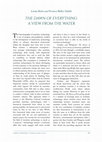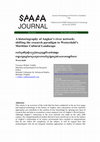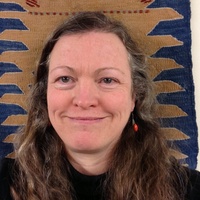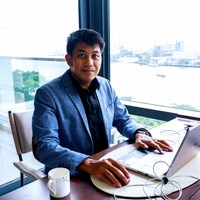Papers by Veronica Walker-Vadillo
Suomen antropologi, Oct 7, 2023
Delivering the Deep. Maritime Archaeology for the 21st century: selected papers from IKUWA 7, 2024
In this chapter we contextualize the genesis of the book and offer an overview of how maritime ar... more In this chapter we contextualize the genesis of the book and offer an overview of how maritime archaeology has evolved over the decades.

suomen antropologi, 2023
The historiography of maritime archaeology is one of margins and peripheries. Linked to the devel... more The historiography of maritime archaeology is one of margins and peripheries. Linked to the development of underwater archaeology, efforts to advance theoretical frameworks within the discipline have been slow at best. There remains a widespread assumption—even among archaeologists—that maritime archaeology deals mostly with shipwrecks and underwater sites, and as such, has little to contribute to broader debates in archaeology. Archaeology remains a terrestrial affair that rarely engages with water worlds, and when it does, it retains its feet firmly on ground. So what do a land archaeologist and an economist have to offer to the world of maritime archaeology?
In spite of its terrestrial focus, The Dawn of Everything speaks to a number of recurring issues in maritime archaeology, where scholars worry about the relationship between terrestrial states and maritime worlds. Such concerns are central to the very constitution of maritime societies: are they hierarchical or heterarchical; are they the same as, or different from the wider societies in which they sit? In the maritime discourse, environmental determinism takes a greater role than Graeber and Wengrow would admit in their book. Graeber and Wengrow’s interest in fluid societies that have the capacity to construct and deconstruct themselves seasonally find their best laboratory in maritime cultural worlds. Both the ancient past and the ethnographic present provide us with an opportunity to understand the contingency of power and decision-making, all within the framework of a seasonal environmental landscape. If nothing else, The Dawn of Everything encourages us to look at each society on its own terms, so let us start by getting our feet wet.
Early Navigation in the Asia-Pacific Region, 2016
The Manila Galleon trade has attracted a great deal of interest from the public and the academic ... more The Manila Galleon trade has attracted a great deal of interest from the public and the academic community alike; As Roberto Junco wrote: they are the stuff of legends (Junco in The archaeology of Manila Galleons, pp. 877–886, 2011). Unfortunately, their fame could lead to their demise if treasure hunting activities are not controlled and academic research is not encouraged. If not kept in check, countries are likely to pass laws that will allow salvage companies to exploit underwater cultural heritage for profit.
The Archaeology of Knowledge Traditions of the Indian Ocean World, 2020

<strong>Historical Ecology of the Mekong River</strong><br> Version 1 (29-06-20... more <strong>Historical Ecology of the Mekong River</strong><br> Version 1 (29-06-2020) If used in a publication, please cite as: Kallio, M., Walker Vadillo, V., 2020, Historical Ecology of the Mekong in a set of 5 diachronic maps. Helsinki, Finland. DOI: 10.5281/zenodo.3827019 The set of maps presented here are an attempt to illustrate the complex dynamics that sit at the heart of the Mekong River Basin, and the long-term interactions that humans have had with this watery world. On the one hand, it aims to capture the changing landscape that follows the regional monsoonal climate, which affects both navigation and water-related resources. It also aims to bring forth the long-term interactions between people and their environment, presenting a diachronic view of late prehistoric, protohistoric, historic, and contemporary settlement sites following geographically-oriented landscape approaches postulated by the Maritime Cultural Landscape (Westerdahl, 1992) and Historical Ecology (Crumley, 1994). The data was originally compiled by Walker Vadillo for her study on river navigation during the Angkor era (see Walker Vadillo, 2016), a work that was made possible by the generosity of the Centre for Khmer Studies (CKS) through their Senior Fellowship program, the ENITAS grant from Chulalongkorn University, and various grants received from the University of Oxford (Oxford Centre for Maritime Archaeology, St. Cross College, and the School of Archaeology). The maps deposited here were funded by the Helsinki Collegium for Advanced Studies through the Core Research Fellowship program. The first version of the map, in the form of a topological map, can be found in Walker Vadillo's doctoral thesis (2016). A monograph based on the thesis is currently in preparation and will be published in the British Archaeological Review (BAR) series <em>Cultural Studies in Maritime and Underwater Archaeology. </em>Further articles in regards to navigation and fish exploitation are currently in preparation, details of publications will be uploaded [...]

Asian Perspectives, 2016
Examining the rock art of the Pak Ou caves in Luang Prabang Province contributes to the archaeolo... more Examining the rock art of the Pak Ou caves in Luang Prabang Province contributes to the archaeological knowledge of Lao People's Democratic Republic (Lao PDR, henceforth referred to as Laos). 1 This article focuses on the curious case of a greencolored "steamship" rock painting that offers unique insights into the history and archaeology of the region. The history of Laos' peoples within the larger South east Asian context remains uncertain. Lorillard (2006) notes that Laotian history is still very much in its infancy, as scholars are struggling with uncritical readings of royal histories and only a small number of archaeological finds within the country's borders. A former French colony, the nationstate of Laos only gained independence in 1953. A civil war left the country relatively isolated within Mainland Southeast Asia. This isolation hindered studies in Laotian archaeology, which have only recently resumed. No archaeological excavations were conducted in Luang Prabang Province, the area under discussion here, between the 1940s and 1980s (White and Bouasisengpaseuth 2008). More recent archaeological work is still nascent and only done in collaboration with foreign researchers (e.g., Demeter et al. 2009; White and Bouasisengpaseuth 2008; Zeitoun et al. 2012). Rock art has received very little attention in Laos. Rock art sites are usually men tioned without substantive presentation or interpretation (Bouxaythip 2011; Srisu chat 1996; Tan 2014a). Luang Prabang Province contains at least four rock art sites, mostly located along the Ou River. Srisuchat (1996) noted the existence of a painted cliff face named Pha Nang Aen located in the vicinity of Pak Ou Village-hence near the Pak Ou caves discussed in this article-but no further information was provided about the site. An additional site, Pha Taem (lit. "Painted Cliff ") is located in the same vicinity near the village of Huoay Kuong; red paintings and handprints can be seen on the cliff face overlooking the Ou River (Bouxaythip 2011). Recent research pre sented by the Middle Mekong Archaeological Project noted red paintings at Dragon Cliff Cave (a log coffin site) and white Buddhist paintings at Tham Pa Ling (a looted prehistoric site) (Bouasisengpaseuth and White 2014; White 2015).
International Journal of Nautical Archaeology, 2009
... New Boat Paintings from Angkor Wat? Veronica Walker-Vadillo. Article first published online: ... more ... New Boat Paintings from Angkor Wat? Veronica Walker-Vadillo. Article first published online: 10 AUG 2009. DOI: 10.1111/j.1095-9270.2009.00242.x. ... More content like this. Find more content: like this article. Find more content written by: Veronica Walker-Vadillo. ...

SPAFA Journal
This article is an overview of the work that has been conducted so far on river usage and nautica... more This article is an overview of the work that has been conducted so far on river usage and nautical technology in the history of Angkor, and a discussion on how maritime approaches can contribute to the creation of new knowledge by opening new lines of research that can help us reconstruct a more nuanced view of Angkor’s fluvial history. Although Angkor’s connection to the river network was made in the early 20th century, the compartmentalized studies that have been carried out so far on the subject of Angkor’s relationship to its watery environment have resulted in interpretations that do not reflect the complexity of the subject. It will be argued here that archaeologists who do not integrate maritime approaches in studies of cultures like Angkor, where waterways play an important role in their environment, are likely to miss important aspects of fluvial cultures. By applying concepts such as the Maritime Cultural Landscape, it will be possible to push beyond the boundaries of terr...

The Oxford Handbook of Early Southeast Asia
Maritime archaeology in Southeast Asia is a vibrant area of research that entails a hugely divers... more Maritime archaeology in Southeast Asia is a vibrant area of research that entails a hugely diverse dataset. Historical and anthropological records are combined with archaeological material in attempts to interpret the tangible and intangible heritage connected to the use of the aquatic environment. Seas, rivers, and lakes create fluid environments and provide space for socioeconomic activities. The role of maritime archaeologists is to interpret that connection and exchange by looking at the issue from a water perspective, taking into account the intricate entanglement between humans, objects, and the watery environment that make up maritime communities. From this perspective, maritime archaeology has also developed specific theoretical frameworks to interpret archaeological data. This chapter provides an overview of the discipline in Southeast Asia, of the current projects and trends, and explores different ways of inquiry that can be used to apprehend human-environment interaction...
SPAFACON 2021: Papers from the SEAMEO SPAFA International Conference on Southeast Asian Archaeology and Fine Arts, 13-17 December 2021
How did Southeast Asia transform from a hub of prehistoric coastal networks into a transregional ... more How did Southeast Asia transform from a hub of prehistoric coastal networks into a transregional interdependent port system by the early modern period? To answer this question, which is crucial to understanding the historical developments of polities along the Indo-Pacific region, this presentation proposes to examine the synergetic nature of shipping infrastructure in order to push current boundaries that place the focus on trade goods.

The set of maps presented here are an attempt to illustrate the complex dynamics that sit at the ... more The set of maps presented here are an attempt to illustrate the complex dynamics that sit at the heart of the Mekong River Basin, and the long-term interactions that humans have had with this watery world. On the one hand, it aims to capture the changing landscape that follows the regional monsoonal climate, which affects both navigation and water-related resources. It also aims to bring forth the long-term interactions between people and their environment, presenting a diachronic view of late prehistoric, protohistoric, historic, and contemporary settlement sites following geographically-oriented landscape approaches postulated by the Maritime Cultural Landscape (Westerdahl, 1992) and Historical Ecology (Crumley, 1994). The data was originally compiled by Walker Vadillo for her study on river navigation during the Angkor era (see Walker Vadillo, 2016), a work that was made possible by the generosity of the Centre for Khmer Studies (CKS) through their Senior Fellowship program, the ENITAS grant from Chulalongkorn University, and various grants received from the University of Oxford (Oxford Centre for Maritime Archaeology, St. Cross College, and the School of Archaeology). The maps deposited here were funded by the Helsinki Collegium for Advanced Studies through the Core Research Fellowship program. The first version of the map, in the form of a topological map, can be found in Walker Vadillo’s doctoral thesis (2016). A monograph based on the thesis is currently in preparation and will be published in the British Archaeological Review (BAR) series Cultural Studies in Maritime and Underwater Archaeology. Further articles in regards to navigation and fish exploitation are currently in preparation, details of publications will be uploaded here as they become available.
Asian Review of World Histories, 2021
... New Boat Paintings from Angkor Wat? Veronica Walker-Vadillo. Article first published online: ... more ... New Boat Paintings from Angkor Wat? Veronica Walker-Vadillo. Article first published online: 10 AUG 2009. DOI: 10.1111/j.1095-9270.2009.00242.x. ... More content like this. Find more content: like this article. Find more content written by: Veronica Walker-Vadillo. ...

The development of the medieval city of Angkor (802-1431 CE) in the floodplains of the Tonle Sap ... more The development of the medieval city of Angkor (802-1431 CE) in the floodplains of the Tonle Sap Lake has lead researchers to believe that Angkor made use of its extensive river network; however, little attention has been given to Angkor’s relationship with its watery environment. Previous studies have presented a fragmentary view of the subject by analysing different components in a compartmentalized way, placing the focus on nautical technology or neglecting discussions on water transport in academic works on land transport. This work aims to provide a more comprehensive study on Angkor’s specific cognitive and functional traits that could be construed as a distinctive form of fluvial cultural landscape. This is done by examining the environment, nautical technology, and the cultural biography of boats within the theoretical framework of the maritime cultural landscape and using a cross-disciplinary approach that integrates data from archaeology, iconography, history, ethnography ...











Uploads
Papers by Veronica Walker-Vadillo
In spite of its terrestrial focus, The Dawn of Everything speaks to a number of recurring issues in maritime archaeology, where scholars worry about the relationship between terrestrial states and maritime worlds. Such concerns are central to the very constitution of maritime societies: are they hierarchical or heterarchical; are they the same as, or different from the wider societies in which they sit? In the maritime discourse, environmental determinism takes a greater role than Graeber and Wengrow would admit in their book. Graeber and Wengrow’s interest in fluid societies that have the capacity to construct and deconstruct themselves seasonally find their best laboratory in maritime cultural worlds. Both the ancient past and the ethnographic present provide us with an opportunity to understand the contingency of power and decision-making, all within the framework of a seasonal environmental landscape. If nothing else, The Dawn of Everything encourages us to look at each society on its own terms, so let us start by getting our feet wet.
In spite of its terrestrial focus, The Dawn of Everything speaks to a number of recurring issues in maritime archaeology, where scholars worry about the relationship between terrestrial states and maritime worlds. Such concerns are central to the very constitution of maritime societies: are they hierarchical or heterarchical; are they the same as, or different from the wider societies in which they sit? In the maritime discourse, environmental determinism takes a greater role than Graeber and Wengrow would admit in their book. Graeber and Wengrow’s interest in fluid societies that have the capacity to construct and deconstruct themselves seasonally find their best laboratory in maritime cultural worlds. Both the ancient past and the ethnographic present provide us with an opportunity to understand the contingency of power and decision-making, all within the framework of a seasonal environmental landscape. If nothing else, The Dawn of Everything encourages us to look at each society on its own terms, so let us start by getting our feet wet.
Delivering the Deep: Maritime archaeology for the 21st century, originated from work presented at IKUWA 7 conference in Helsinki, and offers a comprehensive look at state-of-the-art research being undertaken by maritime scholars. A curated series of essays reviews change in the discipline over the past 50 years and highlights current trends. The wide range of themes presented underscores the changing nature of maritime archaeology, which has expanded from an initial focus on underwater archaeology and nautical technology to become a dynamic, interdisciplinary field encompassing all tangible and intangible elements of culture related to human activities on, in and around aquatic environments. Themes connected to theoretical frameworks, especially those focusing on maritime cultural landscapes, have increased in popularity, a sign of growth in theoretical insights and maturing research. This paves the way for a more nuanced understanding of past societies, their behaviours, technologies, economies, beliefs, and interactions with watery environments.
25 minutos de entrevista sobre mi tesis doctoral para el programa de radio Itsas Tantak en Onda Vasca. Puedes solicitar una copia a traves de un mensaje privado.
https://blogs.helsinki.fi/downbythewater/
Waterways have been key factors in the development of societies from prehistoric times to nowadays, particularly due to their role as vectors for cultural interactions, material exchange, and transmission of knowledge between people and societies. Placing the focus on human-environment interactions in maritime, fluvial, and lacustrine spaces, this interdisciplinary seminar series aims to explore current advances in maritime history, archaeology, and anthropology world wide. The series is hosted by Dr. Veronica Walker, PI of the Ports and Harbours of Southeast Asia project, and Ass. Prof. Dr. Kristin Ilves, lead of the maritime archaeology program at the University of Helsinki and PI of the Survivors of Ragnarok project. Talks for Spanish-speaking audiences will be coordinated and hosted by Dr. Emilia Mataix Ferrandiz, postdoctoral researcher at the Centre of Excellence in Law, Identity and the European Narratives.
Seminar rationale
Following the footsteps of the Down by the Water: interdisciplinary symposium on the role of water transit points in past human societies, celebrated at the Helsinki Collegium for Advanced Studies in 2019, this seminar series will serve as a platform for experts from relevant fields to discuss current advances in the of study of rivers, lakes, seas, and oceans, exploring how these watery spaces have shaped human action.
Seminar virtual venue
Seeing internet as a metaphor for watery networks, and computers as vessels that link people who are apart, we invite you all to join us Down By the Water via Zoom to discover new research projects on maritime-related projects that are taking place world wide in complementary fields such as anthropology, archaeology, ethnography, history, and so on.
Dates and time
The seminar series is projected to be on-going, and will run fortnightly during term time (following the University of Helsinki calendar). The times will have to vary to accommodate speakers’ and hosts’ time zones. The information on dates, time and link will be made available in advance in the website and in our social media.
***Please note that we may require registration for each event to ensure the link to the Zoom seminar is used appropriately, we will provide further updates soon***
Social Media
Follow us on Facebook and Twitter for quick updates
Twitter handle: @4DownByTheWater
Facebook page: https://www.facebook.com/4DownByTheWater/